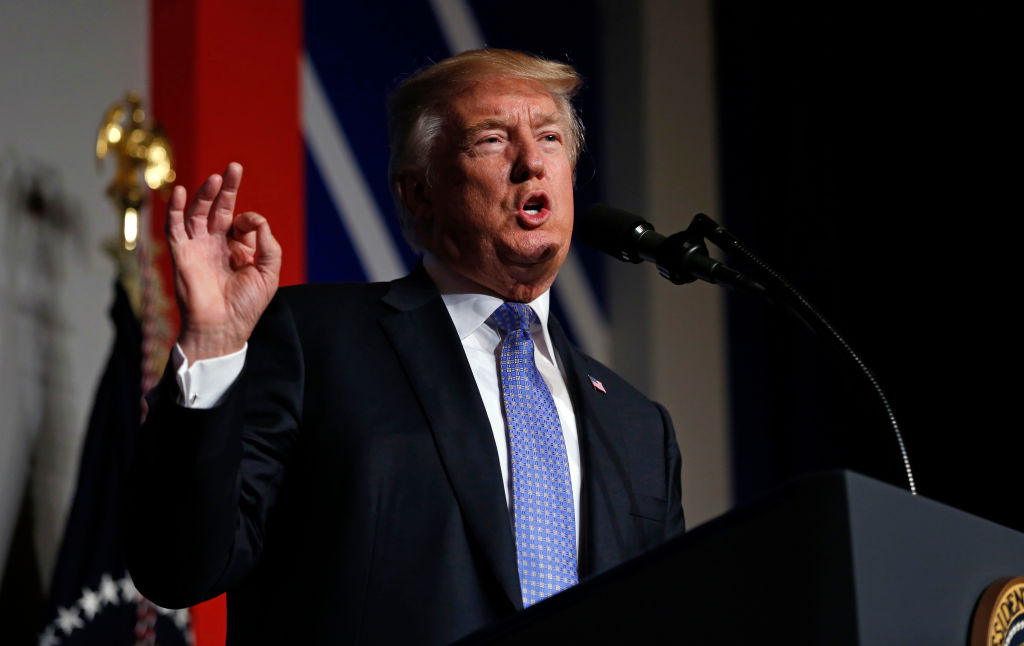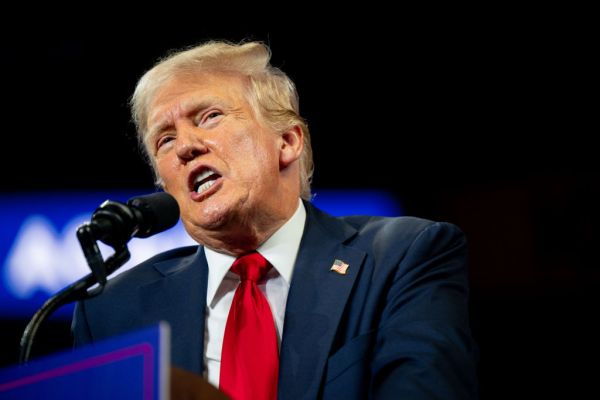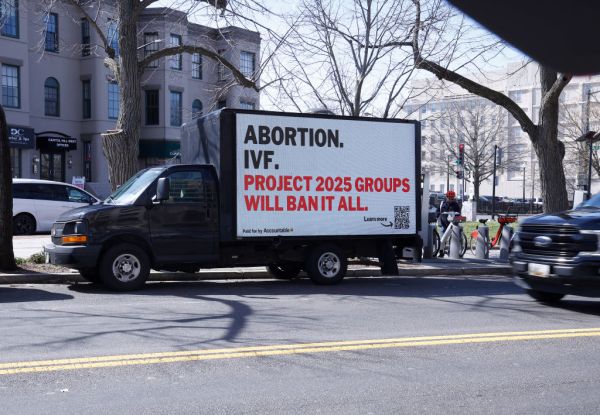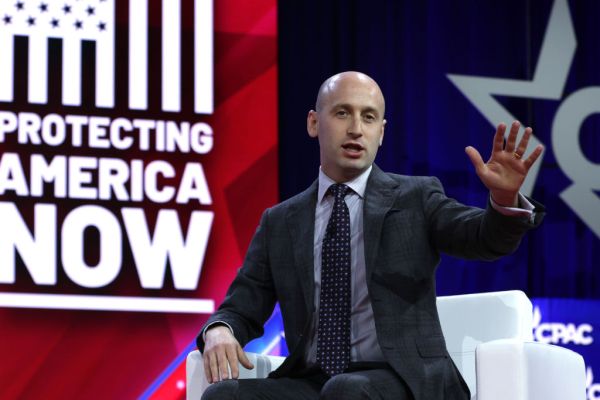Three things can be said about former President Donald Trump’s approach to governing. The first is that he has never been credibly accused of being a dedicated student of public policy. For decades, he focused on real estate and self-promotion, not white papers. During his four years in office, he never gave the impression of being consumed by the philosophical principles of governing or losing sleep over issue briefs.
Second, Trump is not a keep-your-cards-close-the-vest type. History will remember him for saying and tweeting whatever was on his mind at the moment. You never, ever had to wonder what he was thinking. And third, he was never beholden to the positions of his staff. He would ignore, contradict, or fire them. He’d hire people with conflicting views because he knew he’d always ultimately get his way. Donald Trump, for better or worse, was his own man.
This is why the media’s understanding of the Heritage Foundation’s Project 2025 has been so perplexing. Countless articles led readers to believe that his administration would pursue the priorities spelled out in the roughly 900 pages of detailed policy concepts and program minutiae. But that sounds nothing like the Donald Trump we’ve gotten to know.
After allies of the Biden-Harris campaign successfully drew massive negative attention to Project 2025, Trump explicitly distanced himself from the report, even as several media outlets swiftly published pieces pointing out that members of his administration helped write it. Parts of the report are “absolutely ridiculous and abysmal,” Trump explained.
According to the Wall Street Journal, he resented “the notion that the group is ghostwriting his policies.” The Washington Post reported that Trump campaign officials “started saying that people involved in the project would be barred from a second Trump administration.” Then the campaign announced, “Reports of Project 2025’s demise would be greatly welcomed and should serve as notice to anyone or any group trying to misrepresent their influence with President Trump and his campaign — it will not end well for you.” Indeed, the pressure was so great that the project’s director, Paul Dans (a former Trump adviser), stepped down from Heritage.
The negative media reaction prompted a good amount of misinformation, including claims that Project 2025 would ban abortion “without exception” and encourage the teaching of Christian beliefs in public schools. As a Dispatch Fact Check noted, the report does not contain many of the items attributed to it. But two questions remain: First, what does the report actually say? And second, given that Trump presumably supports some of Project 2025 and given that some of its contributors will presumably work in a second Trump administration, should we expect Trump to follow its recommendations?
My reading of Project 2025 is that it tracks Heritage’s direction of the last number of years. The think tank has been producing similar “Mandates for Leadership” since the 1980 election. But the current report reflects the more pugnacious, populist conservatism of today than the measured, libertarian approach common on the right during the Reagan and Bush eras. Its tone is often hot-blooded (e.g., “The Left’s steady stream of insanity appears to be never-ending”). It is committed to addressing what it sees as the nation’s most serious challenges: China’s ambitions, an activist administrative state, climate-change extremism, illegal immigration, and the struggles of the American family.
At times, even a rock-ribbed conservative might think it goes too far. An early chapter sees an inflated role for the director of the Office of Management and Budget that occasionally reads like a deputy president. The chapter on the Commerce Department advocates breaking up and downsizing the National Oceanic and Atmospheric Administration because it is “one of the main drivers of the climate change alarm industry and, as such, is harmful to future U.S. prosperity.” A few authors leave readers with the impression that America is in existential danger (e.g., “If we fail, the fight for the very idea of America may be lost”).
But the report also has features that have gone underreported. An early chapter on the organization of the White House and the management of its policy-development process is informed and prudent. On two contentious issues—the Export-Import Bank and free trade—the report includes contrasting pro/con chapters that make arguments for the next administration to consider. Most chapters have informative discussions of a department’s recent history and descriptions of its key offices and programs.
Which brings us to the second question: Should we expect a second Trump term to be built around Project 2025? Strident Trump opponents would like to convince voters the answer is “yes” so the report can be used to damage his campaign. Strong supporters of the report’s brand of politics likely also hope the answer is “yes,” because they want a president advocating their agenda.
But the answer was always destined to be “probably not.” This is not because of the recalcitrance of career bureaucrats or the ineffectiveness of political appointees, but rather because of Donald Trump himself.
Throughout the report, particularly in Heritage President Kevin Roberts’ foreword, Project 2025 is compared to Heritage’s seminal Mandate for Leadership. Written in 1980, that document was written to help Ronald Reagan navigate that era’s inflation, malaise, international threats, and Washington’s bloat. But there is one important difference between the two reports: Reagan had a clear philosophy. He believed unequivocally in federalism, localism, civil society, reducing federal spending and power, and defeating the Soviet Union. Authors of the 1980 report could apply such principles to policy problems and be reasonably confident their recommendations would align with the incoming president’s vision.
But it is not clear whether key parts of Project 2025 are aligned with Trump. For example, various aspects of the report focus on strengthening the family. One of the top goals of Roger Severino’s chapter on the Department of Health and Human Services is “promoting stable and flourishing married families.” Some on the right understand conservative family policy to mean increasing marriage and birth rates, reducing divorce rates and the number of children growing up in single-parent families, curtailing pornography, and/or enabling more families to live on one income.
It’s not obvious that these goals are his. The platform on his campaign’s website is thin on these social issues. And it’s certainly not obvious that he agrees with his running mate J.D. Vance’s controversial take on how to use federal policy to help families. We must wonder what his actual views are on these matters and what he would do in a second term related to child care, work requirements in child tax credits, and other prominent issues.
Roberts also makes a case for a classical understanding of liberty: “An individual must be free to live as his Creator ordained—to flourish. Our Constitution grants each of us the liberty to do not what we want, but what we ought.” I’m not sure the more libertine Trump sees freedom this way. Similarly, Roberts argues for a communitarian, subsidiarity-style understanding of social life, with families, schools, and voluntary associations leading the way. In fact, his vision reads much like the George H.W. Bush’s 1988 Republican convention speech that lauded community and its constellation of civil-society groups. But again, Trump has given us little reason to believe this is his vision.
Project 2025 argues that, “Conservatives in the states and in Washington, including in the next conservative Administration, should push as hard as possible to protect the unborn in every jurisdiction in America.” Its HHS chapter includes strong language against “mail-order” or chemical abortion. Trump, however, wants to leave abortion decisions up to the states, and he is opposed to banning the abortion pill mifepristone.
The report is mostly emphatic that the federal administrative state must be dismantled. But some associated with today’s “new right” are sympathetic to a stronger administrative state because it could be used to advance conservative priorities. Indeed, if Trump were given a choice between scaling back some federal agency in the name of decentralization and self-government or beefing it up so it could better pursue his goals, I’m not sure I’d bet on the former. In fact, as president, Trump issued an executive order to reshape part of the civil service—an order Trump has promised to reissue since it was rescinded by President Biden. Trump’s policy would have made it easier to replace career officials with political appointees. I wouldn’t be surprised if he sees this as a strategy for making the administrative state strong and loyal, not weak.
A chapter on the White House Office by Rick Dearborn, the deputy chief of staff in the Trump administration, explains not only how the president’s top personnel are organized but also the ideal processes for making and executing decisions. It includes job descriptions of positions like chief of staff and staff secretary, the duties of offices like public liaison, and the roles of councils (like those for domestic policy and national security). It explains how information can best flow to and from the president. What Dearborn describes is sensible, orderly, and historically accurate—his account reflects the structure I saw when I worked for the White House Domestic Policy Council during the George W. Bush administration. However, order and structure are not what Trump—according to much reporting during his first term—appears to actually want.
Similarly, former OMB director Russ Vought’s chapter envisions a powerful role for OMB and its head. OMB should have a “reputation as the keeper of ‘commander’s intent’” and it should be intimately involved in the White House policy process. Its director “must view his job as the best, most comprehensive approximation of the President’s mind as it pertains to the policy agenda” and “must ensure that OMB has sufficient visibility into the deep caverns of agency decision-making.” Again, it is not clear to me that Trump—or the Cabinet secretaries and top aides he hires—would be fond of such delegation to the budget director.
The chapter on education, authored by Heritage’s education director, has significant overlap with Trump’s campaign site. For instance, both prioritize parents’ rights, eliminating the Department of Education, and expanding school choice. Project 2025 goes quite far on choice: “Elementary and secondary education policy should follow the path outlined by Milton Friedman in 1955, wherein education is publicly funded but education decisions are made by families,” it reads. That might go farther than Trump would; it’s unclear if his vision of universal choice means expanded 529 savings accounts, vocal support for state education savings account programs, a federal education tax-credit program, or something bolder.
Right now, people are focused on the fact that Heritage offered recommendations out of step with Trump. But a think tank should not be expected to act—and should never act—as an arm of any campaign. It should be independent. Project 2025 gathered a variety of right-of-center policy leaders to generate ideas that Heritage could present to the next administration.
Given what we have learned over the years about Trump’s philosophically scattered and mercurial approach to governing, it was always unwise to cast this report—or any report for that matter—as the former president’s future playbook. We should anticipate Trump’s future by looking at his past behavior, not by looking to others’ recommendations. We have plenty of direct evidence by which to judge the former president; we need not do it by proxy.










Please note that we at The Dispatch hold ourselves, our work, and our commenters to a higher standard than other places on the internet. We welcome comments that foster genuine debate or discussion—including comments critical of us or our work—but responses that include ad hominem attacks on fellow Dispatch members or are intended to stoke fear and anger may be moderated.
With your membership, you only have the ability to comment on The Morning Dispatch articles. Consider upgrading to join the conversation everywhere.